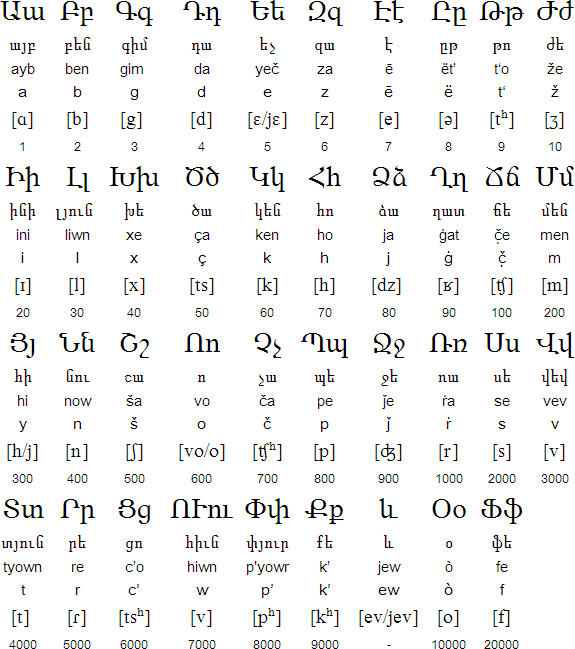Armenian is the offical language of Armenia and Nagorno-Karabakh, and has official status as a minority language in Cyprus, Poland and Romania. Until the the early 1990s schools in Armenian taught in either Armenian or Russian, however after the collapse of the USSR, Armenian became the main medium of instruction and the Russian-medium schools were closed. In 2010 Russian language education was reintroduced in Armenia [source].
A brief history of Armenian
Not much is known about the Armenian language before it was first written in the 5th century AD, though the Armenians are mentioned in inscriptions dating back to the 6th century BC.The type of Armenian spoken and written in the 5th century is known as Classical Armenian, or գրաբար (grabar - "literary"). It contains numerous loanwords from Parthian, and also from Greek, Syriac, Latin and other languages such as Uratian. Grabar continued to be used as a literary language until the late 19th century.
The Armenian used between about the 11th and 15th century is known as Middle Armenian, or միջին հայերեն (mijin hayeren), and contains more loanwords from Arabic, Turkish, Persian, and Latin.
The two main modern forms of Armenian emerged during the 19th century when the traditional Armenian homeland was divided between the Russian and Ottoman Empires. Western Armenian developed among Armenians who had moved to Constantinople, while Eastern Armenian developed among Armenians living in Tbilisi in Georgia. Many newspapers in each of the variants were published and many schools for each variety were set up. This resulted in widespread literacy and to an increase in the amount of literature written in modern Armenian, rather than in the classical language.
Armenian alphabet
In the late 4th century AD, king Vramshapuh of Armenia asked Mesrop Mashtots, one of the officials in his chancellery and a prominent scholar, to create a new alphabet for Armenian. Before then, Armenian had been written with 'cuneiform' scripts, which was deemed unsuitable for religious works by the Armenian Church.Mashtots travelled to Alexandria, where he studied the principles of writing and came to the conclusion that the Greek alphabet was the best alphabet in use at that time because there was an almost one-to-one correspondence between sounds and letters. He used this model to come up with a new alphabet, which he presented to the king when he returned to Armenia in 405 AD. The new alphabet was well-received and a new Armenian translation of the bible was published in 405 AD. Other literary works soon followed.
There are two standard forms of Armenian: Eastern Armenian, spoken mainly in Armenia, Nagorno-Karabakh, Georgia and Iran; and Western Armenian, spoken by the Armenian diaspora in many countries. They are more or less mutually intelligible.
From the early 18th century until the 1950s some 2,000 books were published in Turkish written in the Armenian alphabet, and official documents produced during the Ottoman period were in the Armenian and Arabic scripts. The Armenian alphabet was used in the literature of Kipchak-speaking Armenian Orthodox Christians between 1524 and 1669. The poet Sayat-Nova used the Armenian alphabet to write poems in Azeri, and it was also the official script for Kurdish in Soviet Armenia from 1921-1928.
Notable features
- Type of writing system: alphabet
- Direction of writing: left to right in horizontal lines
- Used to write: Armenian, and formerly used for Turkish, Azeri, Kipchak and Kurdish
- There are a few minor differences in the pronunciation of the letters between the two standard literary forms of Armenian: Western and Eastern.
- Most of the letters have numerical values.
Eastern Armenian (Արևելահայերեն [Arevelahayeren])

Western Armenian (Արեւմտահայերէն [Arevmdahayeren])

Armenian punctuation

Downloads
Download Armenian alphabet charts in Excel or PDF formatSample text in Armenian

Transliteration
Bolor mardik tsnvum en azat u havasar irents' arzhanapatvut'yamb u iravunqnerov. Nranq unen banakanut'yun u khighch & mimyants' petq e' yeghbayrabar veraberven
Translation
All human beings are born free and equal in dignity and rights. They are endowed with reason and conscience and should act towards one another in a spirit of brotherhood.(Article 1 of the Universal Declaration of Human Rights)
Links
Information about the Armenian languagehttp://en.wikipedia.org/wiki/Armenian_language
http://indoeuro.bizland.com/tree/balk/armenian.html
http://www.kwintessential.co.uk/language/about/armenian.html
Online Armenian lessons
http://www.cilicia.com/armo_lesson000.html
http://www.hyeetch.nareg.com.au/learn/intro.html
http://www.armeniapedia.org/index.php?title=Armenian_Lessons
http://hayeren.hayastan.com
A guide to the Armenian alphabet (in Armenian, English and Russian)
http://www.menq.am/tarer_main.htm
Armenian phrases
http://www.terena.org/activities/multiling/unilang/armenian/armenian1.html
http://www.cilicia.com/armo5_phrases.html
http://www.armeniapedia.org/index.php?title=Armenian_Phrases
http://www.phrasebase.com/forum/read.php?TID=107
http://www.littlearmenia.com/html/language/
Free Armenian fonts
http://www.wazu.jp/gallery/Fonts_Armenian.html
http://www.cilicia.com/armo8.html
http://www.armsite.com/software/
http://www.hayfonts.com
http://www.editum.com.ar/mashtots/html/download_fonts.html
Online Armenian transliterators and spell checkers
http://am.translit.us
http://tsca.natverk.org/cgi/armenian.pl
http://www.translitteration.com/transliteration/en/armenian-eastern-classical/iso-9985/
http://www.translitteration.com/transliteration/en/armenian-western/ala-lc/
Online Armenian dicitonaries
http://www.nayiri.com/search?l=en&query=&dt=EN_HY
http://translator.am/en/index.html
http://dict.menq.am/dictfl/flash.html
http://dictionary.hayastan.com/index.php
Armenian Electronic talking dictionaries
http://www.ectaco.com
Online Armenian radio
http://www.hairenik.com
http://www.armenialiberty.org/
http://www.radiovan.am
More Armenian links
http://www.armenianlinks.com









.jpg)
.jpg)

.jpg)





0 comments:
Post a Comment
Note: Only a member of this blog may post a comment.